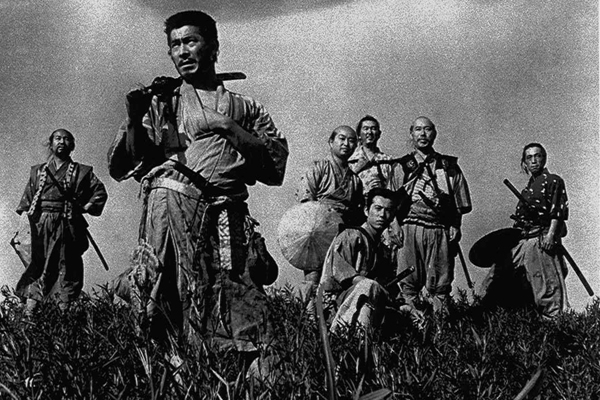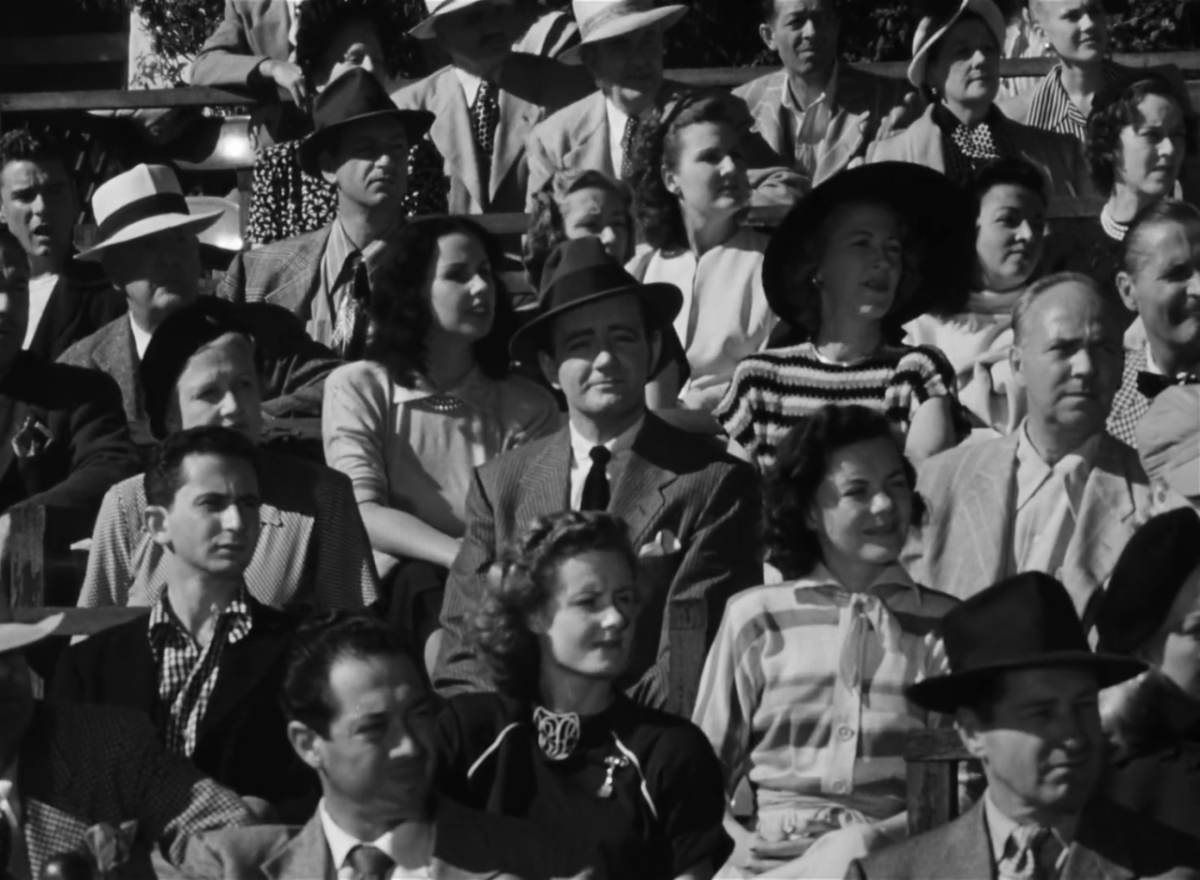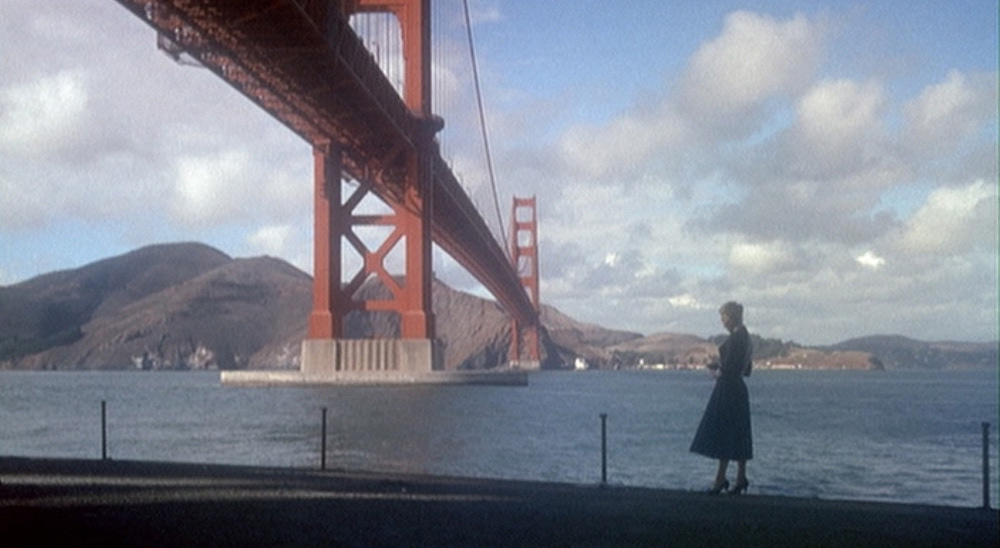Category Archives: 1950s
Seven Samurai (1954)
Roger Ebert – Great Movie Review – 2001:
A farming community learns that the upcoming harvest will result in a raid by a group of thieving bandits. An outspoken worker suggests that they should go to the nearest town and find a group of warriors who will protect them and help them defend their land…
Wait a second, I think I accidentally put A Bug’s Life into the DVD player instead of Seven Samurai… Sorry about that, I’m always getting those two confused. Obviously, I’m not saying that A Bug’s Life is a remake of Seven Samurai, but there is no doubt that it borrows some of its basis for a story on this original ensemble battle film, as did:
 The Guns of Navarone (1961)
The Guns of Navarone (1961)
The Magnificent Seven (1960)
The Good, The Bad, and The Ugly (1966)
Bonnie and Clyde (1967)
The Dirty Dozen (1967)
The Wild Bunch (1969)
Close Encounters of the Third Kind (1977)
Battle Beyond the Stars (1980)
The Road Warrior (1982)
Die Hard (1988)
Ronin (1998)
Saving Private Ryan (1998)
The 13th Warrior (1999)
The Phantom Menace (1999)
Three Kings (1999)
Ocean’s Eleven (2001)
The Inglorious Bastards (2009)
Clearly, this Akira Kurosawa masterpiece tapped into a concept or trope that was so simple it could be the basis for kids movies, westerns, and space comedies. It is the universal desire to see the strong protect the weak and the fact that with a varied group of warriors, we can each find our own place in the story. But just because Kurosawa did it first, does that necessarily mean that this movie is great? Why has this 3 hour and 27 minute epic held the attention of the cinematic community for over 60 years. Why is this movie regarded as highly as it is? Well, let’s recount the basics of the story’s theme along with some character analysis, then we’ll look at Kurosawa’s skill as a director which I believe sheds some light on what makes this film shine after 60 years of imitators have tried to recreate its charm, power, and craftsmanship. Continue reading Seven Samurai (1954)
Vertigo (1958)
 Vertigo is a psychological thriller film directed by Alfred Hitchcock. The film stars Jimmy Stewart as a former police detective John “Scottie” Ferguson, who has been forced into early retirement due to his discovery of crippling acrophobia and vertigo. Scottie is hired as a private investigator to follow a woman, Madeleine Elster (Kim Novak) who is behaving peculiarly. The film received mixed reviews upon initial release, but has garnered acclaim since and is now often cited as one of the defining works of his career. It is currently listed at #65 on the IMDb Top 250, which I think is a travesty. It shows you what type of list the IMDb Top 250 is, to see this film and others, like Citizen Kane, outside of the top 50, but The Dark Knight currently holds the #4 place. But in the 2012 British Film Institute’s Sight & Sound critics’ poll, it replaced Citizen Kane as the best film of all time and has appeared repeatedly in best film polls by the American Film Institute.
Vertigo is a psychological thriller film directed by Alfred Hitchcock. The film stars Jimmy Stewart as a former police detective John “Scottie” Ferguson, who has been forced into early retirement due to his discovery of crippling acrophobia and vertigo. Scottie is hired as a private investigator to follow a woman, Madeleine Elster (Kim Novak) who is behaving peculiarly. The film received mixed reviews upon initial release, but has garnered acclaim since and is now often cited as one of the defining works of his career. It is currently listed at #65 on the IMDb Top 250, which I think is a travesty. It shows you what type of list the IMDb Top 250 is, to see this film and others, like Citizen Kane, outside of the top 50, but The Dark Knight currently holds the #4 place. But in the 2012 British Film Institute’s Sight & Sound critics’ poll, it replaced Citizen Kane as the best film of all time and has appeared repeatedly in best film polls by the American Film Institute.
I have to confess. This is one of those movies that you hear about and want to watch because others say it is so good. I’ve had it on my watch-list for years. This was one of the many Alfred Hitchcock films that my parents owned. But for some reason, unlike North by Northwest or The Birds or Psycho, I just never got around to watching this one. But I finally tackled this one on Saturday last year and have been digesting it ever since. This draft has literally been sitting in my project pile since March 2013 and if WordPress is correct in its count, I have made 67 different revisions in that time. Well, I finally watched it again tonight with the purpose of finishing what I started.
http://www.youtube.com/watch?v=b69YGZizcKc
Ebert’s Great Movies Review from 1996
*** SPOILER ALERT *** Because of the nature of this film, I must warn anyone who reads further on that the rest of this review will contain spoilers. Please take the time to watch this classic before reading any more. *** SPOILER ALERT *** Continue reading Vertigo (1958)
Day 20 – 30 Day Movie Challenge
Favorite Movie by Your Favorite Actor and Actress
[slideshow]
I like this category so much that I am going to break it into two days and do my favorite legacy actor and actress today, and my favorite modern actor and actress tomorrow. Of course, this will turn the 30 Day Movie Challenge into a 31 Day Movie Challenge, but I don’t mind. I have no criteria to separate these except that the classic stars must no longer be making films. Tomorrow, I will get around to my favorite modern actor and actress, but in the meantime…
My favorite classic actor is Jimmy Stewart. He was a tremendously prolific studio actor who worked with all the famous actors and directors of his day. He was known for his performances as an everyman, much like Tom Hanks today. And his beautiful co-star in Rear Window just so happens to be my favorite classic actress, Grace Kelly. She only acted for five years from 1951-1956, but she made a tremendous impact in those five short years even winning an Oscar for acting alongside Bing Crosby in the 1954 film The Country Girl. Sadly, her acting career was cut short by her untimely marriage to Prince Rainier of Monaco. By becoming a princess, she gave up her acting career. However, I don’t know that I have ever seen a more beautiful or talented actress grace the screen.
In Rear Window, Jimmy Stewart plays a professional photographer named L.B. Jeffries who breaks his leg while getting an action shot at an auto race. Confined to his New York apartment during a heat wave, “Jeff” spends his time looking out of the rear window observing the neighbors. He begins to suspect that a man across the courtyard may have murdered his wife. He enlists the help Grace Kelly’s character (a high society fashion-consultant girlfriend named Lisa Freemont) and his visiting nurse Stella (Thelma Ritter) to investigate the situation. Rear Window is currently listed on the IMDB top 250 at #22. It is one of my favorite movies, it has comedy, suspense, and romance.
Day 10 – 30 Day Movie Challenge
Favorite Classic Movie
 This was another category that suffered from the use of vague language. What is a classic movie? What criteria would you use to define a classic? I think what determines a classic film is the same thing that determines a classic piece of literature: the test of time. No film or literature of substandard quality will survive that test. The key to passing this test of time is a work’s universal appeal. This asks for my favorite, not the most classic, so I am pleased to share my favorite classic movie, North By Northwest.
This was another category that suffered from the use of vague language. What is a classic movie? What criteria would you use to define a classic? I think what determines a classic film is the same thing that determines a classic piece of literature: the test of time. No film or literature of substandard quality will survive that test. The key to passing this test of time is a work’s universal appeal. This asks for my favorite, not the most classic, so I am pleased to share my favorite classic movie, North By Northwest.
Alfred Hitchcock made so many movies, but there are three in particular that are generally considered to be his best: Vertigo (1958), North by Northwest (1959), and Psycho (1960). North by Northwest was nominated for Academy Awards for its screenplay, art direction, and editing, but lost all three to Ben-Hur. It placed 40th on the American Film Institute’s 1998 list of the best movies of all time, and it has consistently ranked in the top 50 as ranked by IMDB users.
 The 1950s were a great decade for Alfred Hitchcock. He had so many hits with Strangers on a Train, Dial M for Murder, Rear Window, To Catch a Thief, and The Man Who Knew Too Much. He also had a TV show, Alfred Hitchcock Presents. But in 1958, Vertigo was released and failed to impress critics or audiences. Hitchcock was undoubtedly disappointed by this and couldn’t know that Vertigo would eventually be considered one of his masterpieces. But he vowed that his next project would be a more tested and tried effort that would be more of a crowd-pleaser. The film was a box-office hit, second only to Ben-Hur for the year, and got positive reviews from critics.
The 1950s were a great decade for Alfred Hitchcock. He had so many hits with Strangers on a Train, Dial M for Murder, Rear Window, To Catch a Thief, and The Man Who Knew Too Much. He also had a TV show, Alfred Hitchcock Presents. But in 1958, Vertigo was released and failed to impress critics or audiences. Hitchcock was undoubtedly disappointed by this and couldn’t know that Vertigo would eventually be considered one of his masterpieces. But he vowed that his next project would be a more tested and tried effort that would be more of a crowd-pleaser. The film was a box-office hit, second only to Ben-Hur for the year, and got positive reviews from critics.
 It starred Cary Grant as Roger Thornhill a New York advertising executive who is mistakenly identified as a secret government agent, this put a target on his back. Then he’s framed for murder, this puts him on the run from the police as well as the bad guys. While on the run, he meets Eve Kendall (Eva Marie Saint), who apparently believes his story and wants to help. I’m not going to give you any more about the plot because I want everyone to see it. It has so many iconic scenes and it is still powerful today. It influenced a whole genre of action-suspense-espionage movies. Only three years after its release, the first James Bond film, Dr. No, appeared. Of course, James Bond is a spy, whereas Roger Thornhill was only mistaken for one. But both films have implausible action sequences in outrageous locations like Mount Rushmore. They both have beautiful but mysterious women who take an interest in the hero. And both have a well-dressed leading man who is suave, has a knack for one-liners, a fondness for liquor. You can probably think of dozens of movies since 1959 that have operated on those same principles.
It starred Cary Grant as Roger Thornhill a New York advertising executive who is mistakenly identified as a secret government agent, this put a target on his back. Then he’s framed for murder, this puts him on the run from the police as well as the bad guys. While on the run, he meets Eve Kendall (Eva Marie Saint), who apparently believes his story and wants to help. I’m not going to give you any more about the plot because I want everyone to see it. It has so many iconic scenes and it is still powerful today. It influenced a whole genre of action-suspense-espionage movies. Only three years after its release, the first James Bond film, Dr. No, appeared. Of course, James Bond is a spy, whereas Roger Thornhill was only mistaken for one. But both films have implausible action sequences in outrageous locations like Mount Rushmore. They both have beautiful but mysterious women who take an interest in the hero. And both have a well-dressed leading man who is suave, has a knack for one-liners, a fondness for liquor. You can probably think of dozens of movies since 1959 that have operated on those same principles.
 With North by Northwest, Hitchcock tweaked the basic man-on-the-run story with witty dialogue, charismatic performances, and visually arresting action sequences. He demonstrated that these elements of basic popular entertainment, which are sadly looked down upon by some who call themselves critics, could be applied to big-budget studio films. He showed that a movie could be entertaining, thrilling, and funny, smart and well-produced. It didn’t have to choose to be either high-brow or low-brow. North By Northwest is an extremely entertaining thrill ride. There is not a lot of substance or meaning to it, it is just a tremendously fun roller coaster ride that Hitchcock takes us on. When I first saw it as a kid, I was hooked. And it set a precedent for hundreds of blockbusters that followed in its wake.
With North by Northwest, Hitchcock tweaked the basic man-on-the-run story with witty dialogue, charismatic performances, and visually arresting action sequences. He demonstrated that these elements of basic popular entertainment, which are sadly looked down upon by some who call themselves critics, could be applied to big-budget studio films. He showed that a movie could be entertaining, thrilling, and funny, smart and well-produced. It didn’t have to choose to be either high-brow or low-brow. North By Northwest is an extremely entertaining thrill ride. There is not a lot of substance or meaning to it, it is just a tremendously fun roller coaster ride that Hitchcock takes us on. When I first saw it as a kid, I was hooked. And it set a precedent for hundreds of blockbusters that followed in its wake.


